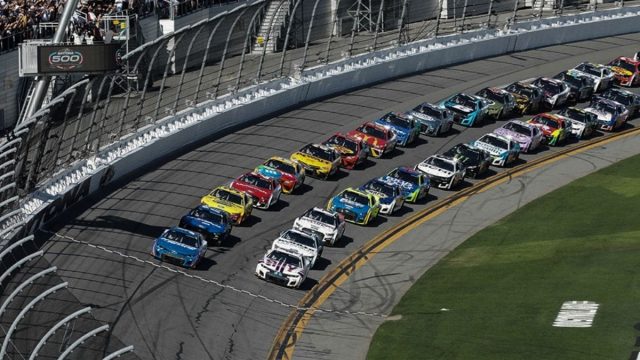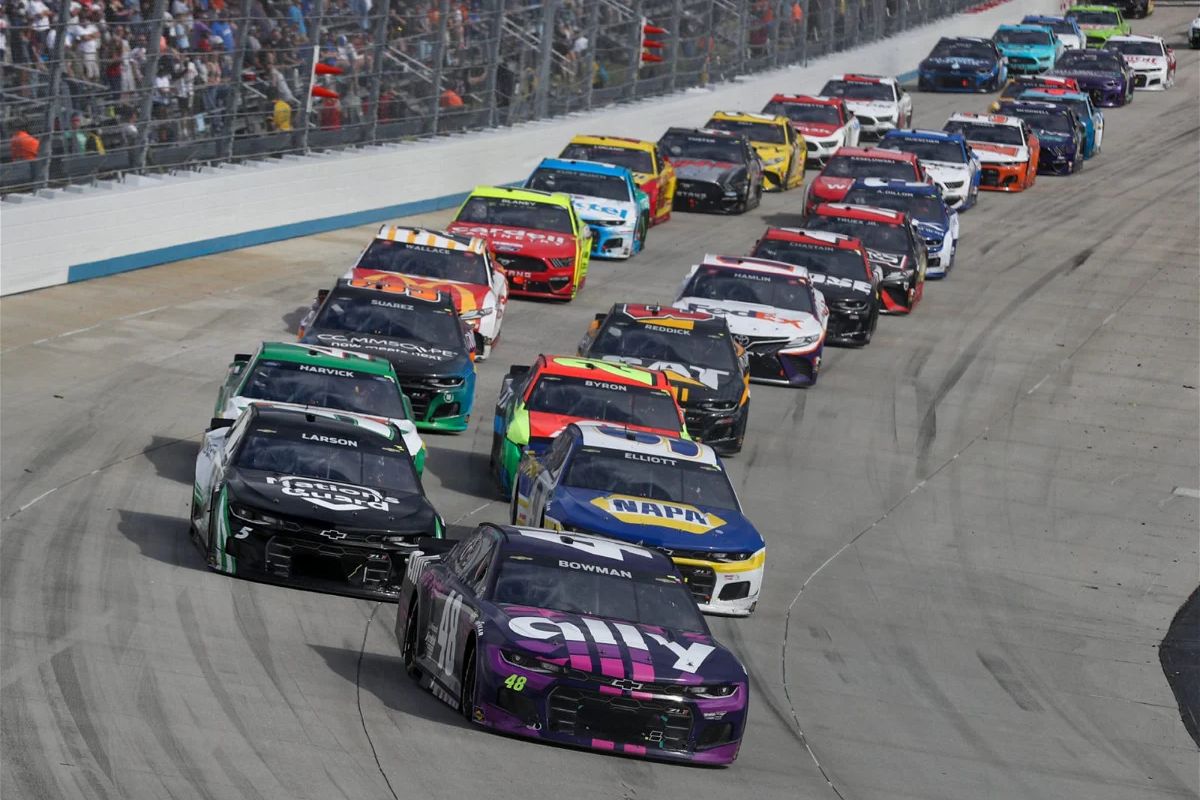NASCAR Tire Gamble at Richmond: As NASCAR gears up for the Cook Out 400 at Richmond, Steve Letarte’s cautionary insights regarding the newly implemented tire rules raise considerable concerns about the potential ramifications for teams and drivers alike. The delicate balance between prime and option tires introduces a layer of complexity that could disrupt established strategies, compounded by unpredictable weather conditions that may influence tire performance. Letarte’s emphasis on the critical nature of tire management during caution periods and restarts suggests that the stakes are exceptionally high, leading one to ponder whether this gamble could reshape playoff trajectories in unforeseen ways.
Key Highlights
- New tire rules at the Cook Out 400 introduce unpredictability, requiring teams to adapt strategies for optimal performance amid changing conditions.
- Steve Letarte emphasizes the critical balance between prime and option tires, which could significantly impact race outcomes and team strategies.
- Increased caution periods may lead to complex tire management decisions, influencing track position and race competitiveness.
- Tire failures pose safety concerns, making effective tire management crucial for driver success and overall safety during the race.
Excitement for Cook Out 400 at Richmond Speedway
Anticipating the return of competitive racing, fans and teams alike are buzzing with excitement for the upcoming Cook Out 400 at Richmond Speedway, a vital event in the NASCAR calendar that promises to showcase the skill and tactics of the sport. This race is particularly notable as it marks a key juncture in the season, where teams will contend not only for immediate success but also for momentum heading into the playoffs.
Richmond Speedway, known for its unique short-track layout, presents a distinctive challenge that tests drivers’ proficiency in handling their vehicles under varying conditions. The tight turns and close-quarters racing demand precision and tactical insight, where every decision made on the track can have profound implications on race outcomes. The stakes are high, and with the Olympic saga concluding, fans are enthusiastic to immerse themselves in the thrilling atmosphere of NASCAR racing.
For Hendrick Motorsports, the anticipation is emphasized by their status as favorites for the championship this year. The team’s history of excellence, coupled with their recent performances, positions them as formidable contenders. This race offers an opportunity for them to solidify their championship aspirations and assert dominance in the series.
As spectators prepare for the race, the palpable excitement reflects not only the allure of high-speed competition but also the intricate strategies that underpin successful racing. The Cook Out 400 will certainly serve as a compelling showcase of the tenacity and skill that define the essence of NASCAR.
NASCAR’s New Tire Rules and Potential Risks
In an ambitious yet contentious move, NASCAR’s implementation of new tire rules has sparked considerable debate among teams and drivers. This highlights both the potential for improved competition and the inherent risks that could undermine the integrity of the racing experience. These changes, intended to improve parity and responsiveness to track conditions, may inadvertently introduce complexities that challenge traditional racing strategies.
Key considerations surrounding the new tire rules include:
- Impact on Race Strategy: Teams may need to adapt their strategies considerably, leading to unpredictable outcomes that could frustrate both competitors and fans.
- Weather Variables: Tire performance may be excessively influenced by weather changes, complicating the decision-making process for teams during races.
- Accessibility of Tires: The availability and procurement of tires could create disparities among teams, potentially favoring those with better resources or connections.
- Increased Risk of Tire Failures: The new rules may lead to unforeseen tire failures, raising safety concerns and impacting race outcomes.
As NASCAR navigates this complex landscape, the balance between innovation and tradition becomes essential. While the intent behind the new tire rules is to foster an improved competitive environment, the potential risks associated with their implementation warrant careful examination to preserve the integrity of the sport.
Steve Letarte’s Analysis of Tire Rules
Steve Letarte’s insightful analysis of NASCAR’s new tire rules reveals the intricate balance teams must navigate between selecting prime and option tires, a dynamic that could considerably impact race strategies at Richmond Speedway.
As Letarte elucidates, the introduction of a prime tire—one that has been a staple for years—coupled with two sets of softer option tires, creates a complex decision-making landscape for teams.
”Prime and Option.” Technically, three and the wets. Don’t let your heads explode. First time in a points-playing event there is a prime tire. Which is the same tire they run at the Richmond forever. But then the teams have two sets of options. Basically, softer tires, more grip, overall, more speed, but for a shorter duration. You know it’s kind of like picture the 100-yard dash versus a mile; that’s the concept of it, right? You can’t run at 100-yard dash speed for a mile because you just run out of air; they lose grip dramatically.” – Letarte
The prime tire, consistent in its performance, offers reliability, while the option tire presents a double-edged sword: increased grip and speed for a limited time. Letarte aptly compares this situation to the difference between sprinting and long-distance running. Just as a sprinter cannot maintain their peak speed over a mile, drivers utilizing the softer option tires must manage their pace to prevent a dramatic loss of grip as the race progresses. This comparison emphasizes the importance of tire management as a critical component of race strategy.
The stakes are raised further by the fact that this is the initial points-paying event featuring this tire combination. Teams must weigh the risk of using the faster option tires against the potential for diminished performance as tire degradation sets in.
View this post on Instagram
Letarte’s analysis highlights that the ability to navigate these tire choices effectively may separate contenders from pretenders, ultimately dictating the outcome of the race. As teams prepare for Richmond, understanding the nuances of tire performance will be paramount in developing a winning strategy.
Potential Complications During Caution Periods
The complexities introduced by the new tire rules become even more pronounced during caution periods, where tactical decisions regarding tire usage can greatly influence race outcomes. As Steve Letarte points out, the dynamics of tire management morph into a labyrinth of strategy under these conditions. The potential for mind-boggling decisions arises, particularly when the frequency of cautions escalates, complicating both pit strategies and driver performance.
“It’s going to be interesting. I think if it’s not a lot of yellows it’s pretty straightforward, but if you start to see some yellow it’s going to get mind-boggling on how these tires might be used.” – Letarte
Key considerations during these caution periods include:
- Tire Wear Management: Teams must evaluate the degradation of existing tires versus the potential benefits of fresher rubber.
- Pit Timing: The timing of when to pit can drastically alter track position, especially if other competitors choose different strategies.
- Caution Frequency: An increase in caution flags can lead to a cascade of unpredictable scenarios, forcing teams to adapt on the fly.
- Driver Performance: Drivers’ ability to handle different tire compounds during restarts can greatly impact their competitiveness.
As the race progresses, these factors intertwine, demanding an acute awareness of tire performance metrics and competitor behaviors. The intricate interplay of strategy and execution during caution periods could ultimately dictate the outcome of the race, demonstrating that tire management in NASCAR is as much an art as it is a science.
Historical NASCAR Gambles and Their Consequences
Throughout its history, NASCAR has navigated a series of high-stakes gambles that have shaped the sport’s landscape, often with profound implications for both its governance and fan engagement. The introduction of notable regulations, such as the points system and stage racing, exemplifies NASCAR’s willingness to innovate, albeit not without initial resistance. These initiatives aimed to improve competitive balance and maintain fan interest, yet they also invited examination and debate regarding their effectiveness.
Conversely, NASCAR has occasionally stumbled due to external pressures and internal miscalculations. The contentious episode with the Environmental Protection Agency (EPA) serves as a clear reminder of the ripple effects that regulatory changes can have on the sport. The EPA’s emission rules not only threatened revenue for states hosting races but also alienated a dedicated fan base, illustrating the importance of aligning governance with stakeholder interests.
Moreover, the ban on wall riding in 2023, following Ross Chastain’s audacious maneuver at Martinsville, raises questions about the balance between innovation and safety. While NASCAR prioritized driver protection, the backlash highlighted a tension between regulatory authority and fan expectations for exhilarating racing.
These historical gambles reveal a pattern: NASCAR’s decisions, whether progressive or regressive, greatly influence its operational framework and the relationship with its fan base. As the sport continues to evolve, the lessons from past gambles serve as both a cautionary tale and a framework for future decision-making in this dynamic arena.
News in Brief: NASCAR Tire Gamble at Richmond
The introduction of new tire rules at the Cook Out 400 presents considerable challenges for teams, as emphasized by Steve Letarte.
The balance between prime and option tires introduces an element of unpredictability that could alter traditional race strategies.
Effective tire management becomes imperative, particularly amidst fluctuating weather conditions and potential caution periods.
Given the historical context of similar gambles within NASCAR, the outcomes of this race may have lasting implications for driver performance and playoff trajectories.
ALSO READ: Truck Series Driver Standings After Richmond’s Race: Who’s Leading the Charge?



